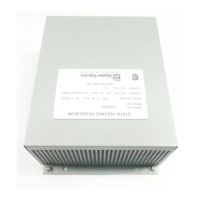3-4
c.
Field Power (Terminals F+ and F-)
.
(1) The model number prefix (SR4A or SR8A) of the regulator, defines the amount of power the unit
is capable of delivering (See Table 1-1).
(2) The dc resistance of the field to which the regulator is connected (terminals F+ and F-) must be
equal to, or greater than, 9
Ω
for an SR4A and 18
Ω
for an SR8A. If the resistance is less than the
specified minimum, a resistor must be added in series with the field. This resistor value plus the field
resistance, must exceed the minimum preceding values.
(3) Good generator voltage stability usually results when the regulator output is above 10 Vdc at no
load (20 Vdc SR8A). Should the voltage be less and a voltage stability problem exists, it may be
necessary to add resistance in series with the field. This resistance raises the regulator output
voltage, thereby increasing the stability signal.
(4) When adding resistance in series with the field, the resistor value must not restrict field forcing
during full load conditions. The following example explains how to compute the proper resistance:
d.
Interconnecting Regulator with Brush Type Rotary Exciters (Terminal A-)
.
(1) When making connections on brush type rotary exciter applications, it is very important to
observe the polarities of the exciter field, exciter output and the generator field as shown in Figure
3-4. If these polarities are not known, the system should be operated on manual voltage control and
the polarities accurately determined, before connecting the voltage regulator into the system. The
voltage regulator could be damaged if interconnection is attempted before this data is known.
(2) When manual voltage control is desired on brush type exciter applications, a
MANUAL-OFF-
AUTO
switch and a field rheostat are used. (See Figure 3-4.) When this feature is not desired, the
output of the exciter can be connected directly to the regulator (terminal A-), to allow self-excitation
during short-circuit or overloads.
(3) When large motor starting or short circuit sustaining capability is not required it is not necessary
to use A- terminal.
e.
Input Power (Terminals 3 and 4)
.
(1) The model number prefix (SR4A or SR8A) of the regulator defines the maximum input power
requirements. (See Table 1-2.) The current requirement of the field, to which the regulator is
operating into, will determine the actual input current. The nominal voltage applied to the regulator
input power stage (terminals 3 and 4) must be 120V for the SR4A and either 208 or 240V for SR8A.
The input power may be taken from any generator lines that provide the correct voltage (line to line
or line to neutral). The phase relationship of this input in relation to other circuits is not important.
EXAMPLE:
An SR4A voltage Regulator is required to operate into an
exciter field that has a dc resistance of 4
Ω
and current requirement of
2.5 Adc at no load and 6 Adc at full load. Since the SR4A requires a
minimum field resistance of 9
Ω
, a resistor of at least 5
Ω
must be con-
nected in series with the field. The regulator output will be 9
Ω
times 2.5
A or 22.5 Vdc at no load, and 9
Ω
times 6 A or 54 Vdc at full load. This
conforms to the 10 volt minimum at no load and provides a sufficient
amount of forcing at full load (up to 90 Vdc).

